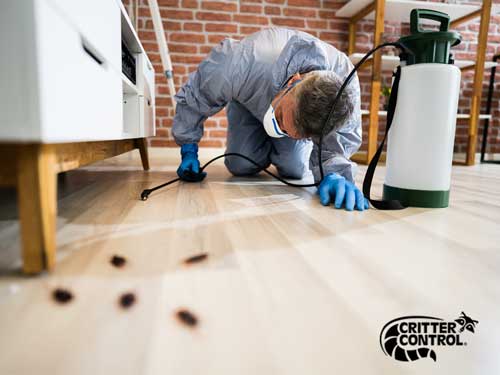Efficient A1 Bed Bug Treatment in Charlotte - Safe and Proven Techniques
Efficient A1 Bed Bug Treatment in Charlotte - Safe and Proven Techniques
Blog Article
Bed Pest Therapy Failure: Contrasting Chemical Vs. Non-Chemical Solutions
In the world of bug control, especially when handling the persistent concern of bed insects, the selection between chemical and non-chemical therapy solutions can be a critical one. Both methods provide distinctive advantages and disadvantages, influencing factors such as performance, safety factors to consider, and total expense. By checking out the nuanced details of each technique, a more clear understanding of which path to seek in dealing with a bed bug invasion can be obtained.
Performance of Chemical Treatments
Chemical treatments for bed pest invasions have been commonly identified for their rapid and potent effectiveness in eliminating these pests. When taking into consideration the efficiency of chemical therapies, it is important to comprehend that they can offer a extensive and quick service to a bed bug problem. Professional pest control operators often count on insecticides to target bed bugs at different phases of their life process, including eggs, nymphs, and grownups. These chemicals typically work by disrupting the bed insects' nerves, leading to paralysis and ultimate fatality.
Furthermore, chemical treatments have the advantage of supplying residual impacts, meaning that they can continue to remove bed pests also after the initial application. This residual action is especially advantageous in combating any type of possible re-infestations. Additionally, the quick action of chemical therapies can bring relief to people encountering extreme bed bug problems, allowing them to restore control of their home promptly.
Security Issues With Chemical Solutions
When making use of chemical services for bed insect therapy is ensuring the security of occupants and the setting,One crucial facet that needs mindful factor to consider. While chemical therapies can be efficient in eradicating bed pests, they may pose threats if not managed appropriately. One of the primary security worries with chemical remedies is the potential injury they can cause to human health and wellness. Exposure to particular chemicals utilized in bed pest treatments can bring about breathing issues, skin irritability, or other adverse responses, especially in individuals with pre-existing problems or sensitivities. Furthermore, inappropriate application or dosage of chemical pesticides can cause poisonous deposits sticking around in the cured location, presenting long-lasting health and wellness dangers to passengers.
Additionally, the environmental effect of chemical solutions is another considerable factor to consider. Some chemicals made use of in bed bug treatments might be harmful to advantageous bugs, wild animals, and ecological communities if they leach right into the dirt or water systems. It is crucial to utilize chemical therapies preventive pest control judiciously, complying with safety and security guidelines, and thinking about much less toxic choices to minimize these risks and ensure the safe and efficient management of bed insect invasions.
Benefits of Non-Chemical Methods
Thinking about the possible security concerns and environmental effect associated with chemical options for bed insect therapy, discovering non-chemical approaches provides an encouraging alternative with several distinct benefits. Non-chemical treatments are environmentally friendly, as they do not contribute to air or water air pollution, making them a lasting option for bug control.
Furthermore, non-chemical solutions can be efficient in targeting bed bugs, including hard-to-reach areas where chemical treatments might not pass through - A1 bed bug exterminator charlotte. Techniques such as warm therapy, vacuuming, steam cleaning, and cushion coverings supply detailed eradication without the usage of hazardous chemicals.
Limitations of Non-Chemical Treatments

Furthermore, non-chemical treatments often require multiple applications to accomplish successful elimination. This More about the author can be time-consuming and may not constantly assure complete removal of all bed bugs and their eggs, especially in hard-to-reach or hidden areas.
Moreover, the success of non-chemical treatments greatly counts on proper application and thoroughness, which can be testing for people without professional know-how. Inadequate application of non-chemical methods may result in insufficient eradication, bring about persistent invasions and the need for added therapies.
As a result, while non-chemical therapies have their advantages, it is important to acknowledge these constraints and consider them when identifying the most efficient method for handling bed pest problems.
Cost Comparison: Chemical Vs. Non-Chemical Options
Provided the limitations associated with non-chemical therapies, an important aspect to examine in the context of bed bug administration is the cost contrast between chemical and non-chemical options. In contrast, non-chemical therapies like warmth treatment or heavy steam can be more costly, with costs ranging from $1,000 to $6,000 for a whole home. While the first cost of chemical treatments might seem reduced, several treatments may be called for to totally eradicate the infestation, potentially increasing the total expense.
Final Thought

Taking into consideration the potential security issues and environmental impact linked with chemical solutions for bed bug therapy, exploring non-chemical techniques offers a promising option with a number of distinct benefits.Offered the limitations linked with non-chemical treatments, a vital facet to evaluate in the context of bed insect administration is the expense comparison in between chemical and non-chemical options. In comparison, non-chemical therapies like heat therapy or heavy steam can be a lot more expensive, with costs ranging from $1,000 to $6,000 for an entire home. While the preliminary expense of chemical therapies might seem reduced, multiple therapies may be called for to totally get rid of the problem, possibly raising the overall cost.In conclusion, when contrasting chemical and non-chemical bed bug therapy options, it is essential to consider effectiveness, security, benefits, restrictions, and price.
Report this page